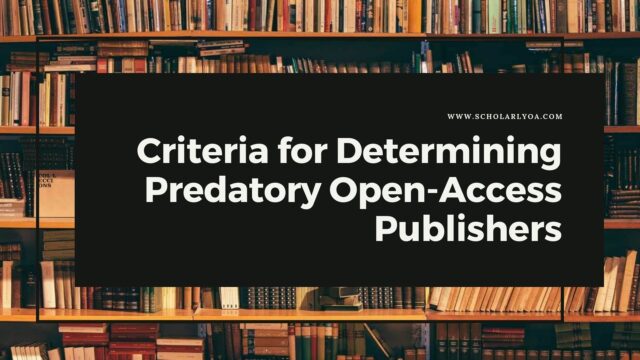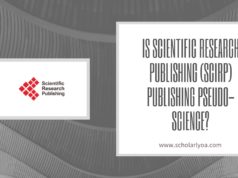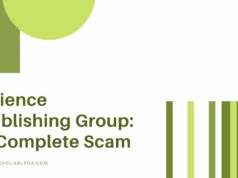
Today I am publishing a list of the criteria I use for determining predatory open-access publishers. The document is available as a PDF at the link below, and the blog post contains the full-text of the criteria. Thank you to OASPA, COPE, and STM for their leadership in establishing scholarly publishing industry standards.
Criteria for Determining Predatory Open-Access Publishers [PDF]
Criteria for Determining Predatory Open-Access Publishers
By Jeffrey Beall August 4, 2012
1. Analyze the publisher’s content, practices, and websites according to established ethical standards.
A. Open Access Scholarly Publishers Association (OASPA) Code of Conduct
B. Committee on Publication Ethics (COPE) Code of Conduct for Journal Publishers [PDF]
C. International Association of Scientific, Technical & Medical Publishers (STM) Code of Conduct

2. Analyze the publisher’s content, practices, and websites, contact the publisher if necessary, read statements from the publisher’s authors about their experiences with the publisher, and determine whether the publisher commits any of the following that are known to be committed by predatory publishers.
A. Publish papers already published in other venues
B. Publish papers that contain plagiarism
C. Copy “authors guidelines” verbatim (or with minor editing) from other publishers
D. List false or insufficient contact information, including contact information that does not clearly state the headquarters location or misrepresents the headquarters location (e.g. through the use of addresses that are actually mail drops)
E. Publish journals that are excessively broad (e.g., Journal of Education) in order to attract more articles and gain more revenue from author fees
F. Publish journals that combine two or more fields not normally treated together (e.g. International Journal of Business, Humanities and Technology)
G. Enlist members of editorial boards that are not experts in the field; have an insufficient number of board members; have made-up editorial boards (made up names); include scholars on an editorial board without their knowledge or permission; have board members who are prominent researchers but exempt them from any contributions to the journal except the use of their names and photographs; provide insufficient contact/affiliation information about board members (e.g., M. Khan, Pakistan).
H. Require transfer of copyright and retain copyright on journal content. Require the copyright transfer upon submission of manuscript.
I. Fail to state license information on articles or does not seem to understand journal article licensing standards.
J. Have poorly maintained websites, including dead links, prominent misspelling and grammatical errors on the website.
K. Use language claiming to be a “leading publisher” even though the publisher is a startup or no one has ever heard of it before.
L. Make unauthorized use of licensed images on their website, taken from the open web, without permission or licensing from the copyright owners
M. Use spam email to solicit manuscripts or editorial board memberships
N. Demonstrate a lack of transparency in its operations
O. Have no membership in industry associations and does not follow industry standards
P. Engages in acts of deception
Q. Set up shop in a first-world country chiefly for the purpose of functioning as a vanity press for scholars in a developing country
R. Begin operations with a large fleet of journals, often using a template to quickly create each journal’s home page
S. Lack a published article retraction policy or retract articles without a formal statement; also the publisher does not publish corrections or clarifications and doesn’t have a policy for these
T. Claim to have a peer review but does not
U. Do not use ISSN numbers, DOI numbers or use them improperly or makes them up.
V. Do not identify who is the owner or chief operating officer of the operation or do not identify other officers of the operation
W. Use email addresses that end in .gmail.com, yahoo.com, or uses some other free email supplier
X. The “contact” us page only lists a webform
Y. Do minimal or no copyediting
Z. Copy journal titles from other publishers
AA. Use text on the publisher’s main page that describes the open access movement and then place the publisher in the context of fulfilling the movement’s goals
BB. Use strange names to attempt to draw attention to the publisher (e.g. Wudpecker Journals)
CC. Provide links to legitimate conferences and associations on the publisher’s main website in order to steal some of the organizations’ legitimacy and paint the publisher with it.
DD. Have duplicate editorial boards (i.e. same editorial board for more than one journal)
EE. For the name of the publisher, use names like “Network,” “Center,” “Association,” “Institute,” etc. when it is only a publisher and does not meet the definition of the term used.
FF. Falsely claim to have the publisher’s content indexed in legitimate abstracting and indexing services
GG. Have excessive advertising on the publisher’s site to the extent that it interferes with site navigation and content access
HH. Have no policies or practices that relate to digital preservation
II. Publish papers that are pseudo-science
JJ. Provide insufficient information or hide information about author fees and then publish an author’s paper and then send the author an invoice
KK. Misrepresent the true country of publication in the publisher’s name (e.g. Canadian Center of Science and Education)
LL. Falsely claim to have an impact factor, or use some made up measure (e.g. view factor) to make it look like the publisher’s articles have international standing
MM. Have links like “Privacy policy” or “Terms of use” that don’t really link to anything
NN. Display prominent statements that promise rapid publication, quick review, etc.
OO. Have a contact address that turns out to be somebody’s apartment
PP. Focus on authors (not readers) and on getting their fees at the expense of readers, and offers few or no value adds to readers such as RSS feeds, hotlinked references, etc.
QQ. When an author submits a paper, the publisher asks the corresponding author for suggested reviewers. Then the publisher uses the suggested reviewers without sufficiently checking their qualifications. This allows authors to create fake online identities and review their own papers.
RR. The publisher or its journals are not listed in standard periodical directories or are not cataloged in library databases
SS. The publisher is set up and run by a single man who is very entrepreneurial; the man may have business administration experience, and the site has business journals but it also has journals that are outside the experience of the entrepreneur or anyone on his staff
TT. For life sciences journals that report on research involving human or animal subjects, the publisher does not have any code of ethics regarding the research with these subjects
UU. Do not require authors to declare that they have no conflicts of interest regarding the publication of their papers
VV. Send spam requests for peer reviews to scholars unqualified to review the paper in question.












